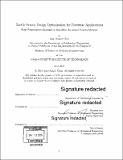Tactile sensor design optimization for footwear applications from piezoresistive elastomer to Hall-effect integrated sensing methods
Author(s)
Chen, Ann Annie
DownloadFull printable version (9.246Mb)
Other Contributors
Massachusetts Institute of Technology. Department of Mechanical Engineering.
Advisor
Sangbae Kim.
Terms of use
Metadata
Show full item recordAbstract
Our ability to move across various terrains depends heavily on the mechanical interactions between our feet and the external environment. Understanding how to best replicate mechanoreceptors in feet can lead to major improvements in plantar sensing for athletic performance analysis and medical devices. However, current plantar sensing technologies are unable to meet the associated demands for accuracy, sensitivity, and durability. In addition, current sensors are also unable to withstand the large impact forces and inertial noise associated with human locomotion. To address this issue, this thesis investigates alternative designs for a tactile force sensors that are largely inspired by mechanoreceptors found in human skin. Two different sensing methodologies will be analyzed: piezoresistive elastomer and Hall-effect integration. The piezoresistive elastomer method will involve testing mixtures of urethane or silicone rubbers with various conductive substances such as carbon black. Compressing the sensors at various forces will correspond to lower resistance measurements as more electrical connections are made by the conductive particulates. Though these designs have high sensitivity to changes in force, the resulting data is inconsistent and slow to stabilize due to material creep. The Hall-effect integrated method will involve a magnet and four Hall-effect sensors molded in an elastomer matrix. Compressing the sensors will register different readings in each of the four embedded Hall-effect sensors which will correspond to a certain shear and deflection measurement. This sensor design shows promise as a cost-effective plantar sensor, but additional analysis is needed.
Description
Thesis: S.B., Massachusetts Institute of Technology, Department of Mechanical Engineering, 2018. Cataloged from PDF version of thesis. Includes bibliographical references (pages 51-54).
Date issued
2018Department
Massachusetts Institute of Technology. Department of Mechanical EngineeringPublisher
Massachusetts Institute of Technology
Keywords
Mechanical Engineering.